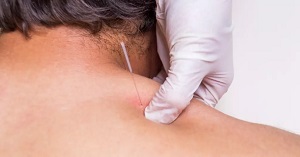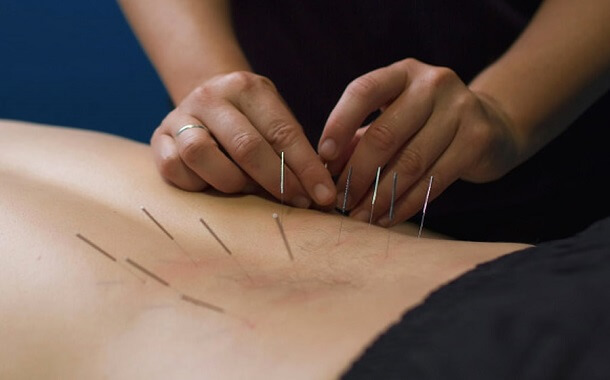How Much Does Dry Needling Cost?
Last Updated on December 27, 2023
Written by CPA Alec Pow | Content Reviewed by ![]() CFA Alexander Popinker
CFA Alexander Popinker
Dry needling is a very popular procedure used to treat pain. With the help of very fine needles that are inserted in particular locations of your body, practitioners are able to treat some types of pain. These target areas are known as trigger points. This procedure is known as a “dry” technique so that you don’t confuse it with other treatments that will inject fluids through needles. The dry needling technique involves no injections or fluids.
Dry needling is also known as myofascial trigger point dry needling or just trigger point dry needling. The name “Myofascial” comes from the muscle pain people experience when they have injured themselves or worked out too hard. Although this condition is chronic, it will only be limited to certain locations, and not your whole body.
Places in which the muscle has been contracted or knotted are referred to by specialists as trigger points. It creates a tight spot that can be very sensitive even to slight touches or pressures, making pain radiate down the whole muscle. Dry needling is usually used to fix issues around the heels, back, and hips, but also the neck and shoulders.
How much does dry needling cost?
The cost of the dry needling treatment will be somewhere between $45 and $360 or more, depending on several factors like the number of sessions you will need, the practitioner you work with, your location, and others. Practitioners will have a varying price for dry needling sessions, charging as low as $15 or as high as $60 or more per session.
You are likely to need anywhere between 3 and 6 dry needling sessions depending on your issue and the way in which your body reacts to the treatment.
If the procedure isn’t covered by your insurance plan, you should ask your practitioner about any discounts offered for multiple sessions, as this is a great way of reducing costs right off the bat. There are also practitioners that have reduced rates explicitly made available for clients that don’t have dry needling coverage or medical insurance at all.
Before you go ahead and book an appointment for dry needling treatment, you should get in touch with the insurance company you work with to see whether this treatment is covered or not. If it is covered, you should then check what you’ll need to provide the company to make sure they process the claim. Most insurance companies also have a list of in-network or preapproved practitioners.
How is dry needling different from acupuncture?
Although similar in the fact that both techniques use very fine dry filament needles, dry needling and acupuncture are very much different.
Acupuncture is a very popular traditional Chinese medicine. It has been performed over the course of centuries. The Acupuncturist practitioner will insert similar needles into acupuncture points in the body of the patient, as a way of relieving both physical and mental problems. According to Acupuncturists, better energy flow, known as Qi, is promoted through acupuncture points.
These needles aren’t inserted only in the area that experiences pain. Instead, they are placed all over the body, in places that seem to have no connection to your problem. So although a patient might have facial pain, for example, they might have needles inserted in their arms and/or legs as well.
And acupuncture isn’t used to treat just pain. Practitioners will also use it for treating the following conditions, among others:
- Repetitive stress injuries
- Nausea
- Fibromyalgia
- Allergies
- Addictions
Dry needling became popular around the 1980s, although it was developed somewhere around the 1940s in the Western world. It is a procedure that will treat pain directly in the affected muscle tissue. Dry needling will most likely need to be performed together with other treatments like chiropractic or physical therapy, while acupuncture is usually used as a stand-alone treatment.
There are providers that have packages combining dry needling with acupuncture when dealing with patients with myofascial pain experienced in combination with issues that might be fixed with acupuncture.
What are the benefits of dry needling?
Dry needling can be used to treat myofascial pain in patients that have not been able to relieve it with traditional medications and treatments like physical therapy.
Dry needling is a treatment considered minimally invasive. This is because the inserted needles won’t stay too long in the muscle or go very deep inside it. There are people who have experienced total relief of the pain they were experiencing with the help of dry needling, completely eliminating, or at least reducing, their intake of pain medicine after a few sessions.
Dry needling can also be used in tandem with other therapies to increase their chances of success. For example, this procedure is known to increase the chance of positive results from physical therapy, because people will feel less pain or muscle stiffness.
Who performs dry needling?
Dry needling can be used by healthcare providers like physicians, chiropractors, acupuncturists, and physical therapists, as long as they have the necessary training to do it. The types of practitioners approved to perform dry needling are still regulated at the state level.
Don’t use the services of a dry needling provider if you’re unsure of their qualifications. Don’t be shy about asking about their level of experience, as well as their dry-needling certification and training.
How is dry needling performed?
Dry needling is a treatment that can be performed in a clinic or at the provider’s office. The patient will need to lie down in a position that enables easy access to the trigger points that need to be targeted.
As soon as the trigger points are confirmed, the practitioner will clean the skin to reduce the risk of developing an infection. The area is then held and pinched off, and then, a very fine sterile microfilament needle will be inserted directly in the trigger point. This will lead to a contraction of the muscle, that will pull tight and then relax.
Depending on the pain type that has to be treated, the depth of the needle placement will vary. There are short needles that only go several millimeters deep under the skin, but there are longer ones as well, that can go 25 or even 125 mm deep into your muscle and fascia.
You might also like our articles on the cost of acupuncture, Bowen therapy, or trigger point injection.
While some people might need the needle to stay under their skin for as much as 10 to 15 minutes, others will only keep it for a few seconds, depending on their particular issues. The needle can also be moved up and down several times, a process done by the practitioner depending on your needs.
While some people might feel a slight cramping or pinching feeling, others say they don’t feel the needles at all as they are inserted into their skin.
The needles are only used once and then disposed of for sanitary purposes.
The day of your dry needling
 Before going to a dry needling session, you won’t have to make any special preparations, although this is still something you should discuss with the practitioner, just to confirm. You should wear loose clothing. Before going through dry needling, if you’re under any prescription medication and especially blood thinners (anticoagulants), you should speak with the prescribing doctor and see if any issues can arise.
Before going to a dry needling session, you won’t have to make any special preparations, although this is still something you should discuss with the practitioner, just to confirm. You should wear loose clothing. Before going through dry needling, if you’re under any prescription medication and especially blood thinners (anticoagulants), you should speak with the prescribing doctor and see if any issues can arise.
If you take prescription medication, your dry-needling provider should know about this as well.
If you want to know how long the procedure will take and what exactly it involves, then talking to the provider will be the best choice. It is also very important that you don’t move while you have the needles inserted. This will allow you to relax and unwind.
After the treatment is done, it’s not uncommon for the soreness to develop around the muscles, but it shouldn’t be stronger than the soreness you feel after a great workout. And it won’t be long until it goes away. You can apply a warm compress if you want the muscle to relax faster.
What are the risks and potential complications of dry needling?
Although dry needling is considered a very safe procedure, there are still people who should avoid it. Among these are:
- People that might not understand what the treatment involves and will become agitated or move a lot
- People with a strong phobia of needles
- People that have had recent surgery or take blood thinners, although they should still talk to the practitioner as it depends on their particular condition
- As not enough research has been done to dismiss any issues of dry needling in pregnant people, they should also avoid the procedure. Acupuncture should also be avoided if you’re pregnant, as it is thought that some acupuncture points might stimulate early labor or miscarriage.
Risks and side effects of dry needling
Complications after dry needling sessions are very rare, although there may be some side effects you should consider. These will include:
- Temporary increase in the exact pain that you’re treating with the needling
- Nausea
- Fainting
- Fatigue
- Bleeding
- Bruising
- Sore muscles
There is also a very rare complication that happens if the needle used for dry needling goes too deep and punctures a lung or another organ.
What should you expect after dry needling?
It’s not uncommon for people to feel soreness after the dry needling sessions. If you have mild discomfort after the session of dry needling, try any of these tricks:
- Increase the amounts of fluids you drink for the next two days
- Go for some mild, over-the-counter anti-inflammatory solutions
- Try to stretch the affected area lightly
- Apply either heat or an alternation of heat and ice over the area
- Take a warm bath with Epsom salts
When should I call my doctor?
If you have concerning side effects, don’t waste precious time and talk with the provider as soon as possible. Look for things like:
- Bruising that instead of going away, gets worse
- Any signs of a possible infection. These include fever, pus, or redness in the needled area
- A strong increase in pain
- Bleeding you can’t seem to stop


Leave a Reply
Want to join the discussion?Feel free to contribute!